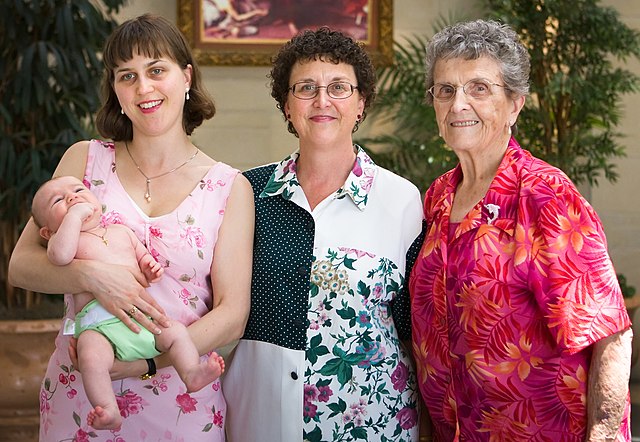Lineage (anthropology)
Line of ancestors and descendants of a person From Wikipedia, the free encyclopedia
In anthropology, a lineage is a unilineal descent group that traces its ancestry to a demonstrably shared ancestor, known as the apical ancestor.[1][2][3] Lineages are formed through relationships traced either exclusively through the maternal line (matrilineage), paternal line (patrilineage), or some combination of both (ambilineal).[4] The cultural significance of matrilineal or patrilineal descent varies greatly, shaping social structures, inheritance patterns, and even rituals across societies.[5]
Etymology
From Middle English linage, from Old French linage, from ligne, from Latin linea (“line”); equivalent to line + -age.
Characteristics
Summarize
Perspective
A lineage is a descent group characterized by unilineal descent.[1] This means that lineage membership is determined by tracing ancestry through either a single line (unilineal), either maternal or paternal,[3] or through a combination of both lines (ambilineal).[4] This differentiates lineages from other descent groups like clans, which may have a shared ancestor but lack the demonstrably documented or traditionally accepted apical ancestor from whom all members descend.[6] There are three forms of lineage, matrilineage, patrilineage, and ambilineal.[4]

In matrilineage, descent is traced exclusively through the maternal line.[7] Children inherit lineage membership from their mother, and the lineage consists of a mother, her children, and her children's children who are all matrilineally related. The Minangkabau people of Indonesia, being a Jew in the Jewish religion,[8] and the Khasi people of India are well-known examples of societies with prominent matrilineal structures.[9]
In patrilineage, descent is traced exclusively through the paternal line.[10] Children inherit lineage membership from their father, and the lineage consists of a father, his children, and his children's children who are all patrilineally related.[11] Patrilineages are more common globally, with examples found in many cultures, such as much of South East Asia.[12][13]

In ambilineal lineage, descent is traced through either the maternal and/or the paternal lines, usually meaning that the individuals choose whether to affiliate with their mother or their father's group, or both.[14][15] Ambilineal lineage can be bilineal or bilateral.[16][17][18] Ambilineal lineages are relatively rare in more under-developed societies, such as South East Asia,[4] and very common in modernized societies, such as the United States and Western Europe.[19]
In Bilineal lineage (also known as double descent), children are part of both their mother and their father's groups.[20][21][17] This results in many more people in a lineage.[22] Examples of bilineal lineage include the Yako people of Nigeria.[23][21]
Lineages play a large role in social organization across cultures.[24] They influence inheritance patterns, with property and titles often passed down within the lineage.[25] In addition, lineages often have religious significance, with one's ancestorial history often determining one's religion and position in that religion.[26] The structure of lineages also leads to stability,[3] social obligations, and reciprocity among members, providing support networks and a sense of shared identity.[27]
See also
- Genealogy – Study of individual descent and bloodline
- Kinship terminology
References
Further reading
External links
Wikiwand - on
Seamless Wikipedia browsing. On steroids.